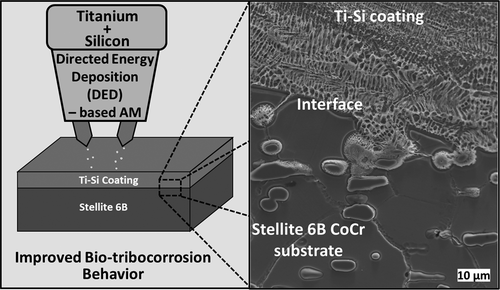当前位置:
X-MOL 学术
›
ACS Appl. Mater. Interfaces
›
论文详情
Our official English website, www.x-mol.net, welcomes your
feedback! (Note: you will need to create a separate account there.)
Titanium–Silicon on CoCr Alloy for Load-Bearing Implants Using Directed Energy Deposition-Based Additive Manufacturing
ACS Applied Materials & Interfaces ( IF 8.3 ) Pub Date : 2020-11-09 , DOI: 10.1021/acsami.0c15279 Jose D. Avila 1 , Murat Isik 1 , Amit Bandyopadhyay 1
ACS Applied Materials & Interfaces ( IF 8.3 ) Pub Date : 2020-11-09 , DOI: 10.1021/acsami.0c15279 Jose D. Avila 1 , Murat Isik 1 , Amit Bandyopadhyay 1
Affiliation

|
Cobalt–chromium (CoCr) alloys offer outstanding wear resistance when compared to other biocompatible metallic materials and are extensively used in articulating surfaces of total hip and knee arthroplasty. However, CoCr alloys’ biocompatibility is known to be inferior to titanium (Ti). Wear- and corrosion-induced metal-ion release from CoCr alloys has been reported to cause cancer and negative physiological impacts. In this study, CoCr alloy was coated with commercially pure Ti (CpTi) and CpTi–Silicon (CoCrTi–Si) with the specific objective of reducing Co and Cr ion release during articulation, without degrading the excellent wear resistance of the CoCr alloy. Directed energy deposition (DED), a blown powder-based laser additive manufacturing technique, was utilized to process CpTi- and CpTi–Si-based coatings on Stellite 6B commercial CoCr alloy. Scanning electron microscopy (SEM), X-ray diffraction (XRD) analyses, and hardness testing found that refined carbides and titanium silicides increased the hardness from 321 ± 13 to 758 ± 48 HV0.5. Tribological studies determined a comparable wear rate between Stellite 6B alloy and CoCrTi–Si in DI water but a statistically significant reduction in Dulbecco’s Modified Eagle Medium (DMEM). The wear rates for Stellite 6B were 8.5 ± 0.8 × 10–5 and 12.9 ± 0.4 × 10–5 mm3/Nm in DI water and DMEM, respectively. While the wear rates for CoCrTi–Si were 9.1 ± 0.5 × 10–5 and 8.9 ± 0.8 × 10–5 mm3/Nm in DI water and DMEM, respectively. Contact resistance acquisition displayed the presence of a passive film formation during tribological testing. ICP-MS results for Stellite 6B and CoCrTi–Si concluded a reduction of Co ions release in DI water from 149.8 ± 66.7 to 17.5 ± 0.7 ppb and a reduction in Cr ions release from 66.7 ± 32.4 to 18.0 ± 0.5 ppb, respectively. In DMEM media, Co ion release for Stellite 6B and CoCrTi–Si reduced from 10.1 ± 1.4 to 4.1 ± 0.2 ppb and Cr ion release for Stellite 6B and CoCrTi–Si reduced from 8.7 ± 0.2 to 5.0 ± 0.7 ppb, respectively. The current study revealed a new mode of manufacturing for CoCr alloy-based load-bearing implants that can reduce toxic metal ions release due to wear- and corrosion-induced damages.
中文翻译:

CoCr合金上的钛-硅用于基于定向能量沉积的增材制造的承重植入物
与其他生物相容性金属材料相比,钴铬(CoCr)合金具有出色的耐磨性,并且广泛用于髋关节和膝关节置换术的关节表面。但是,已知钴铬合金的生物相容性不如钛(Ti)。据报道,磨损和腐蚀引起的CoCr合金中金属离子的释放会导致癌症和负面的生理影响。在这项研究中,CoCr合金镀有商业纯钛(CpTi)和CpTi-硅(CoCr Ti-Si)的特定目的是减少铰接过程中Co和Cr离子的释放,而不会降低CoCr合金的优异耐磨性。定向能量沉积(DED)是一种基于吹塑粉末的激光增材制造技术,用于在Stellite 6B商业CoCr合金上处理基于CpTi和CpTi-Si的涂层。扫描电子显微镜(SEM),X射线衍射(XRD)分析和硬度测试发现,精炼的碳化物和硅化钛将硬度从321±13升高到758±48 HV 0.5。摩擦学研究确定Stellite 6B合金和CoCr Ti-Si在去离子水中的磨损率相当,但在统计学上显着降低了Dulbecco的改良Eagle介质(DMEM)。Stellite 6B的磨损率为8.5±0.8×10在去离子水和DMEM中分别为–5和12.9±0.4×10 –5 mm 3 / Nm。在去离子水和DMEM中,CoCr Ti-Si的磨损率分别为9.1±0.5×10 –5和8.9±0.8×10 –5 mm 3 / Nm。接触电阻的采集显示了在摩擦学测试中存在被动成膜的情况。ICP-MS的Stellite 6B和CoCr Ti-Si结果表明,去离子水中的Co离子释放量分别从149.8±66.7降低到17.5±0.7 ppb,Cr离子释放量也从66.7±32.4降低到18.0±0.5 ppb。在DMEM介质中,Stellite 6B和CoCr Ti–Si的Co离子释放Stellite 6B和CoCr Ti-Si的Cr离子释放量从10.1±1.4 ppb降低到4.1±0.2 ppb,分别从8.7±0.2 ppb降低到5.0±0.7 ppb。当前的研究揭示了一种基于CoCr合金的承重植入物的新制造方式,该方式可以减少由于磨损和腐蚀引起的损坏而释放的有毒金属离子。
更新日期:2020-11-18
中文翻译:

CoCr合金上的钛-硅用于基于定向能量沉积的增材制造的承重植入物
与其他生物相容性金属材料相比,钴铬(CoCr)合金具有出色的耐磨性,并且广泛用于髋关节和膝关节置换术的关节表面。但是,已知钴铬合金的生物相容性不如钛(Ti)。据报道,磨损和腐蚀引起的CoCr合金中金属离子的释放会导致癌症和负面的生理影响。在这项研究中,CoCr合金镀有商业纯钛(CpTi)和CpTi-硅(CoCr Ti-Si)的特定目的是减少铰接过程中Co和Cr离子的释放,而不会降低CoCr合金的优异耐磨性。定向能量沉积(DED)是一种基于吹塑粉末的激光增材制造技术,用于在Stellite 6B商业CoCr合金上处理基于CpTi和CpTi-Si的涂层。扫描电子显微镜(SEM),X射线衍射(XRD)分析和硬度测试发现,精炼的碳化物和硅化钛将硬度从321±13升高到758±48 HV 0.5。摩擦学研究确定Stellite 6B合金和CoCr Ti-Si在去离子水中的磨损率相当,但在统计学上显着降低了Dulbecco的改良Eagle介质(DMEM)。Stellite 6B的磨损率为8.5±0.8×10在去离子水和DMEM中分别为–5和12.9±0.4×10 –5 mm 3 / Nm。在去离子水和DMEM中,CoCr Ti-Si的磨损率分别为9.1±0.5×10 –5和8.9±0.8×10 –5 mm 3 / Nm。接触电阻的采集显示了在摩擦学测试中存在被动成膜的情况。ICP-MS的Stellite 6B和CoCr Ti-Si结果表明,去离子水中的Co离子释放量分别从149.8±66.7降低到17.5±0.7 ppb,Cr离子释放量也从66.7±32.4降低到18.0±0.5 ppb。在DMEM介质中,Stellite 6B和CoCr Ti–Si的Co离子释放Stellite 6B和CoCr Ti-Si的Cr离子释放量从10.1±1.4 ppb降低到4.1±0.2 ppb,分别从8.7±0.2 ppb降低到5.0±0.7 ppb。当前的研究揭示了一种基于CoCr合金的承重植入物的新制造方式,该方式可以减少由于磨损和腐蚀引起的损坏而释放的有毒金属离子。

































 京公网安备 11010802027423号
京公网安备 11010802027423号